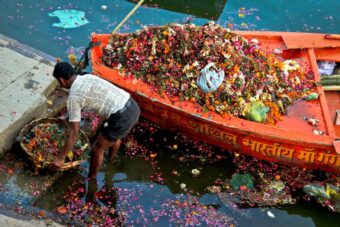Ganga Cleaning: Restoring the Sacred River
At Kashi Educare Society, we are deeply committed to the preservation and restoration of one of the world’s most revered and vital natural resources—the Ganga River. The Ganga, known as the lifeline of millions, is not only a sacred river but also an essential source of water for drinking, agriculture, and sanitation for over 400 million people in India. Sadly, due to rapid urbanization, industrial pollution, and untreated waste, the Ganga is under severe threat, with its waters becoming increasingly polluted and its ecosystems deteriorating.
Our Ganga Cleaning Initiative aims to restore the river to its natural, pristine state—ensuring it remains a source of life and reverence for generations to come.
The Importance of the Ganga River
The Ganga is more than just a river. It is deeply intertwined with the culture, spirituality, and livelihood of millions of people. It provides water to over 100 cities and towns, irrigates vast agricultural lands, and supports rich biodiversity. As the spiritual center for millions of Hindus, the Ganga holds profound cultural significance, with countless rituals, festivals, and pilgrimages centered around its banks.
However, over the years, the river has suffered from excessive pollution, including industrial discharge, untreated sewage, plastic waste, and agricultural runoff. The health of the river is directly linked to the health of the communities that depend on it, making its restoration critical for both ecological balance and human well-being.
The Challenges of Ganga Cleaning
Cleaning the Ganga is not a simple task. The challenges are multifaceted and require an integrated approach that combines technology, community involvement, and policy changes. Some of the key challenges include:
- Pollution from Industrial Effluents: Many factories along the Ganga’s banks discharge untreated industrial waste into the river, causing severe chemical contamination.
- Untreated Sewage: A significant portion of the sewage from nearby cities flows into the river without proper treatment, leading to high levels of pathogens and organic pollutants.
- Plastic and Solid Waste: Non-biodegradable waste, including plastics, waste from pilgrims, and household garbage, are often dumped into the river, leading to long-term environmental harm.
- Degradation of Ecosystems: The Ganga’s rich aquatic life, including fish and aquatic plants, is under threat due to pollution and habitat destruction.
- Lack of Wastewater Treatment Infrastructure: Many communities along the river lack sufficient infrastructure for treating wastewater before it is released into the river.
Our Ganga Cleaning Initiative
Our mission is clear: to restore the Ganga River to its natural glory, ensuring it is clean, safe, and sustainable for future generations. Through a combination of grassroots action, innovative solutions, and partnerships with government agencies, local communities, and environmental experts, we are working to:
1. Promote River Clean-Up Drives
We organize and support regular clean-up campaigns along the banks of the Ganga, involving local communities, volunteers, and environmental activists. These campaigns focus on removing plastic, waste, and other debris from the river and its surrounding areas, as well as raising awareness about the harmful effects of pollution.
2. Wastewater Treatment Projects
One of our core strategies is to implement and improve wastewater treatment facilities. We work with local governments and communities to develop low-cost, efficient solutions for treating sewage before it reaches the river. This includes supporting the installation of decentralized sewage treatment plants and promoting eco-friendly solutions such as biofilters and natural waste treatment systems.
3. Advocacy and Policy Engagement
We engage with policymakers at local, state, and national levels to advocate for stronger regulations on industrial pollution, improved waste management practices, and the enforcement of environmental laws. We push for investments in wastewater treatment infrastructure and seek government support for ongoing river conservation efforts.
4. Community Education and Awareness
We believe that the long-term success of our initiative depends on the active participation of local communities. Our education programs focus on teaching communities about the importance of the Ganga, the impacts of pollution, and the need for responsible waste disposal. We also encourage people to participate in religious and cultural practices in ways that minimize their impact on the river.

